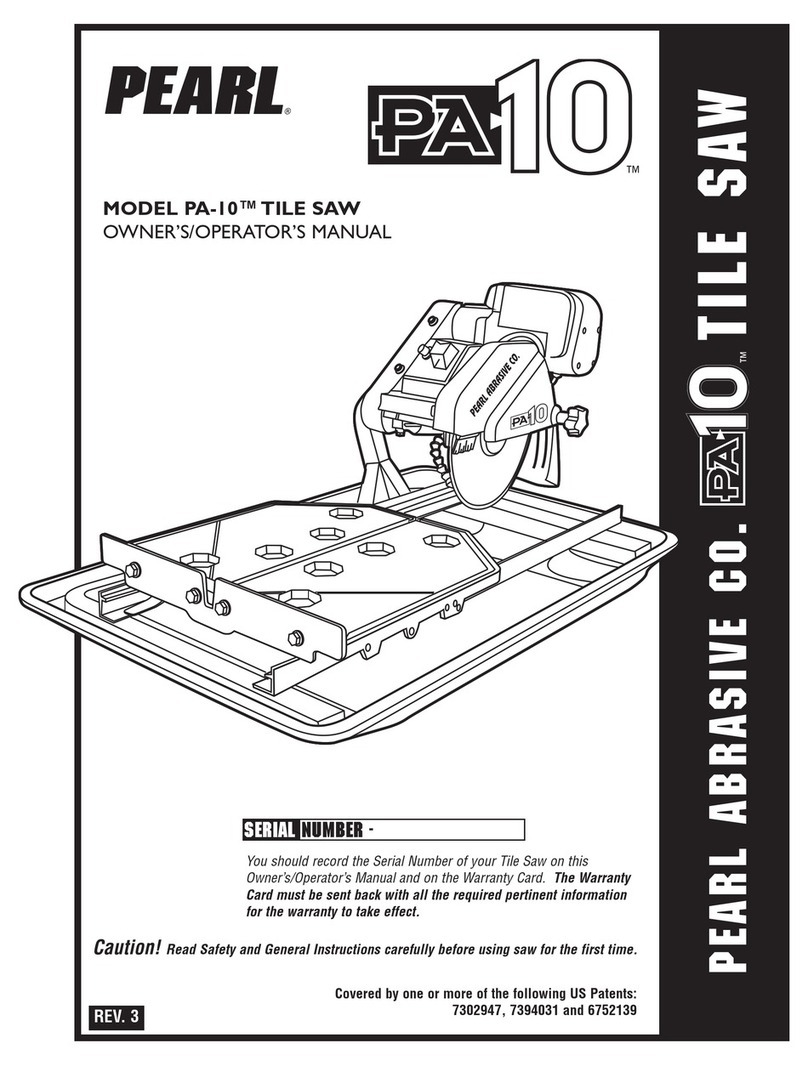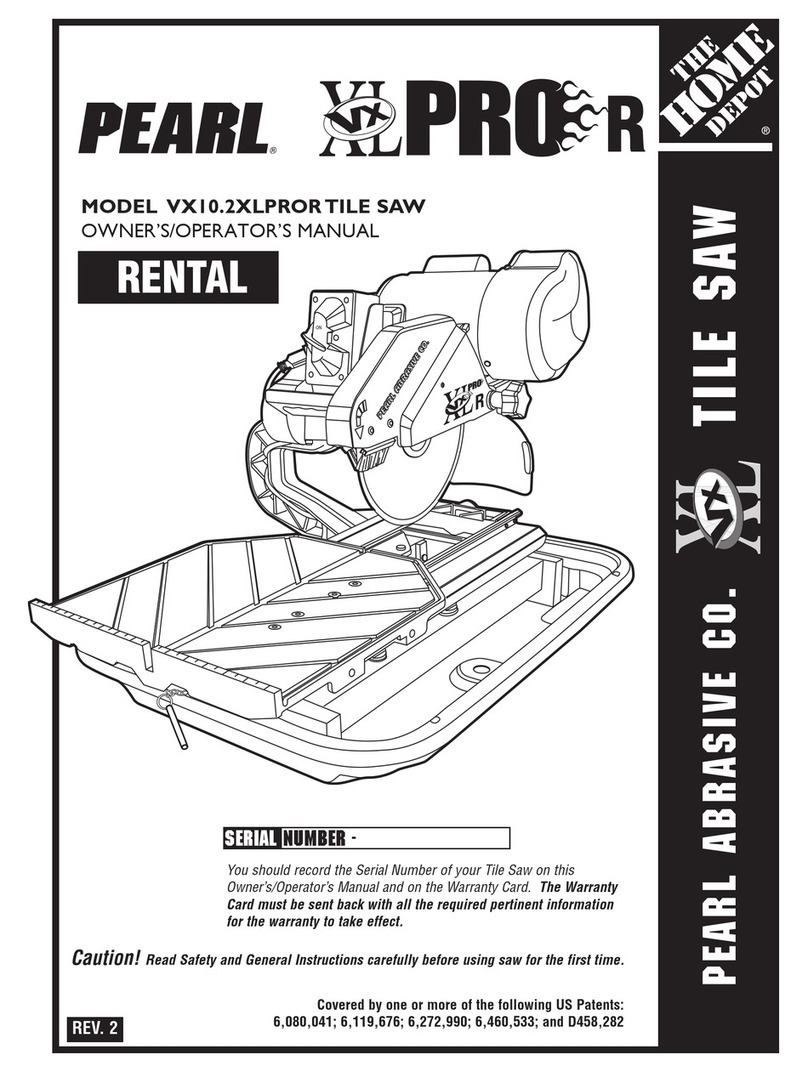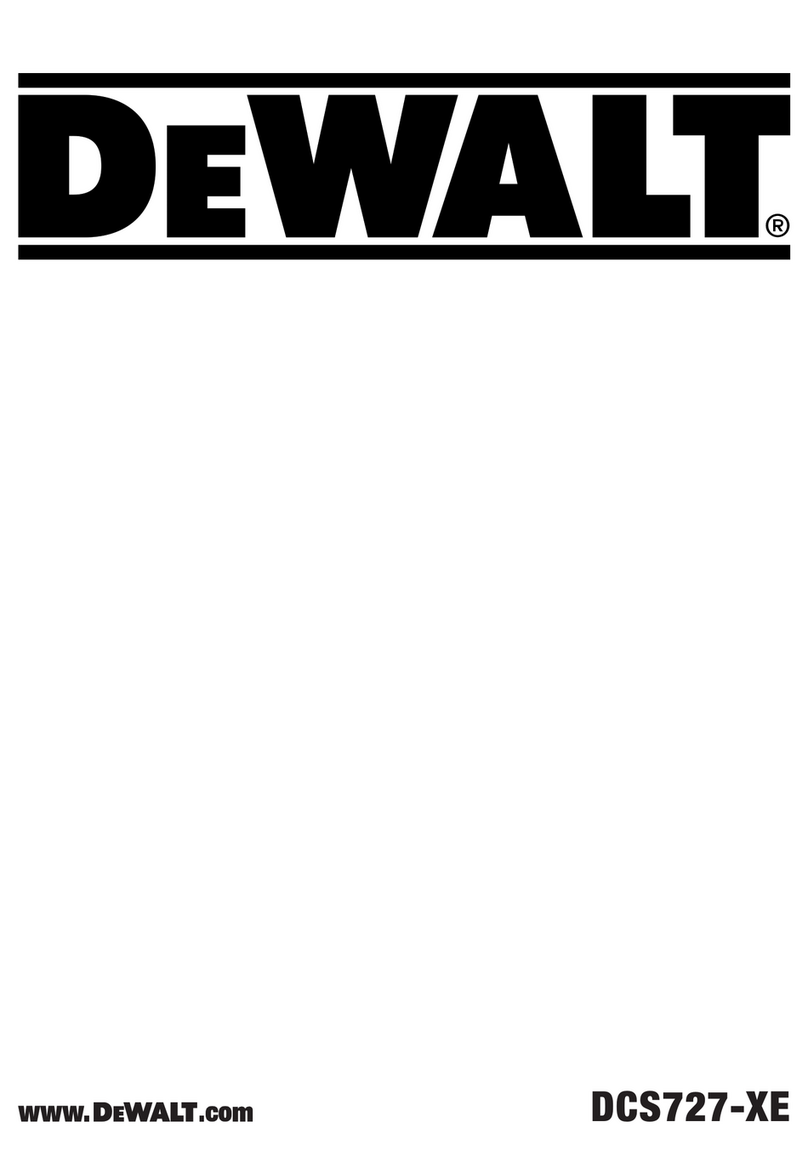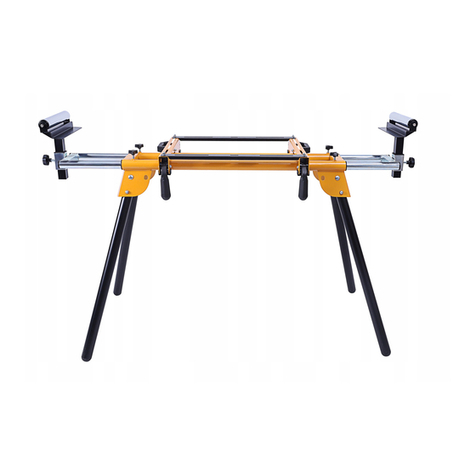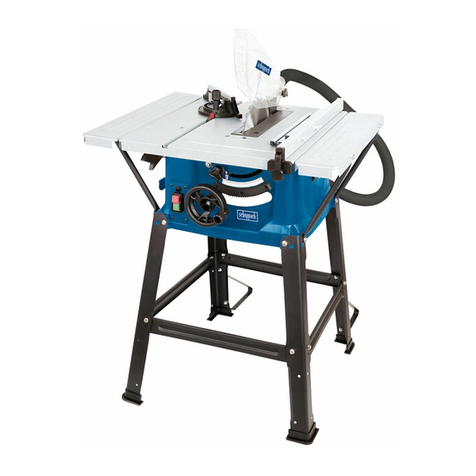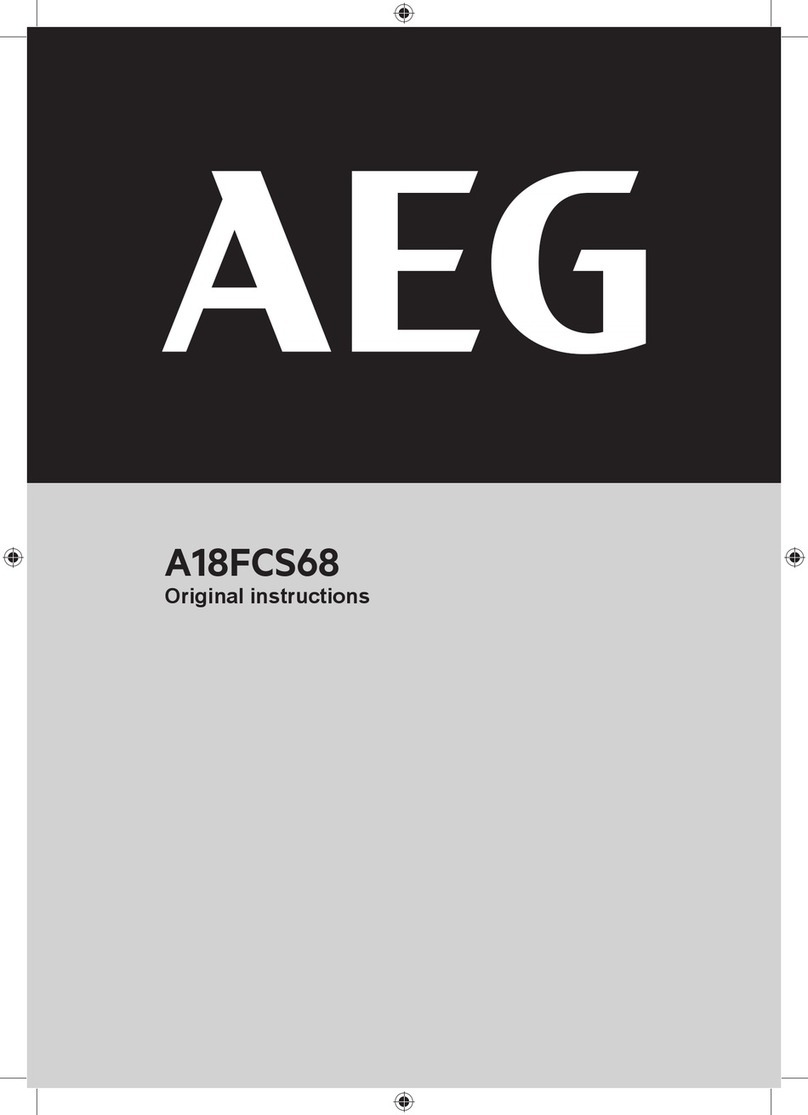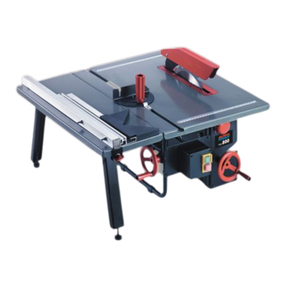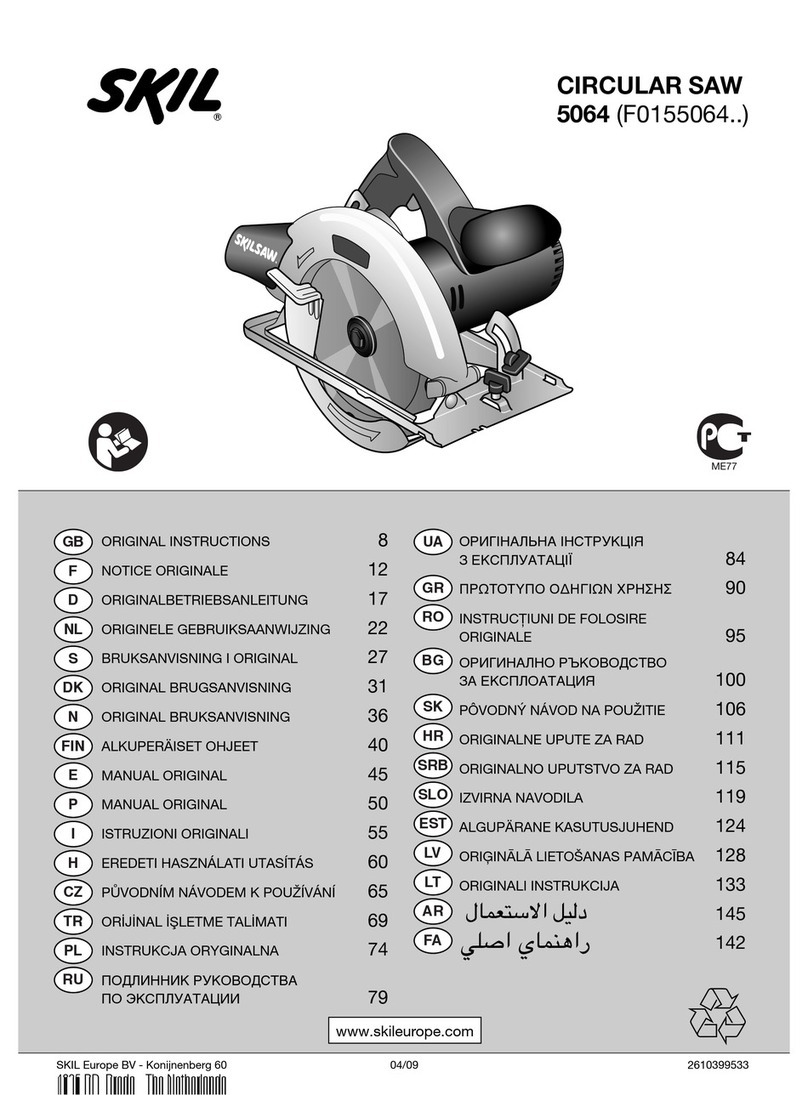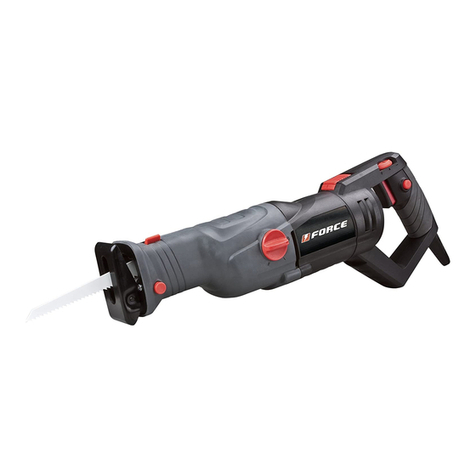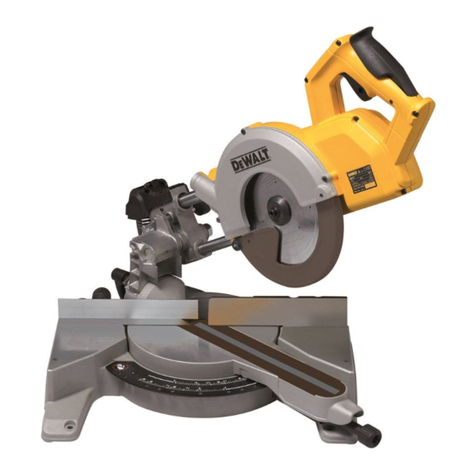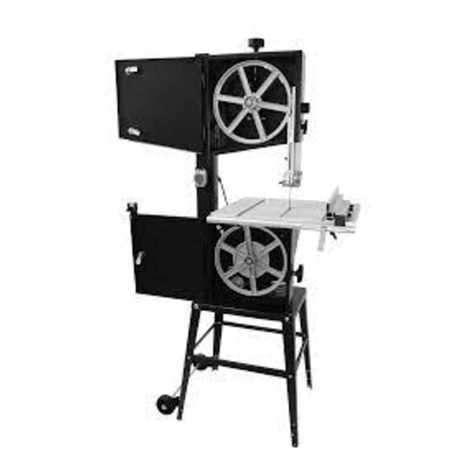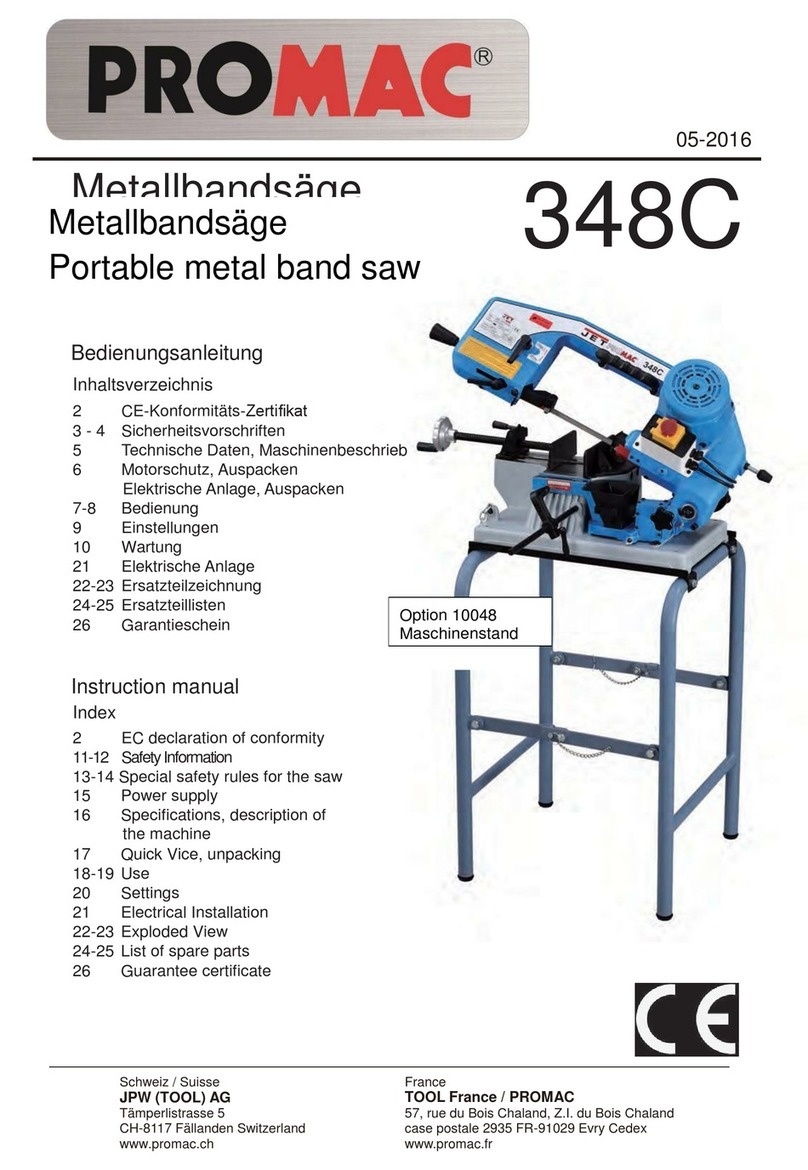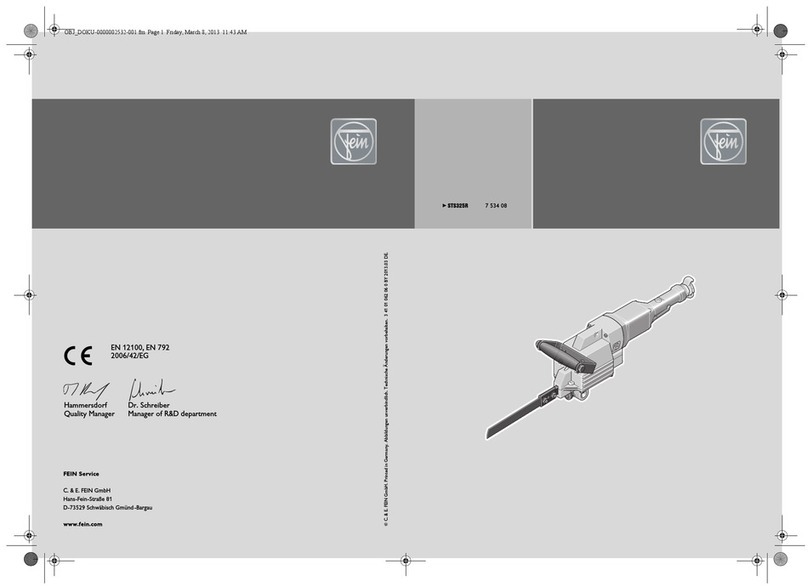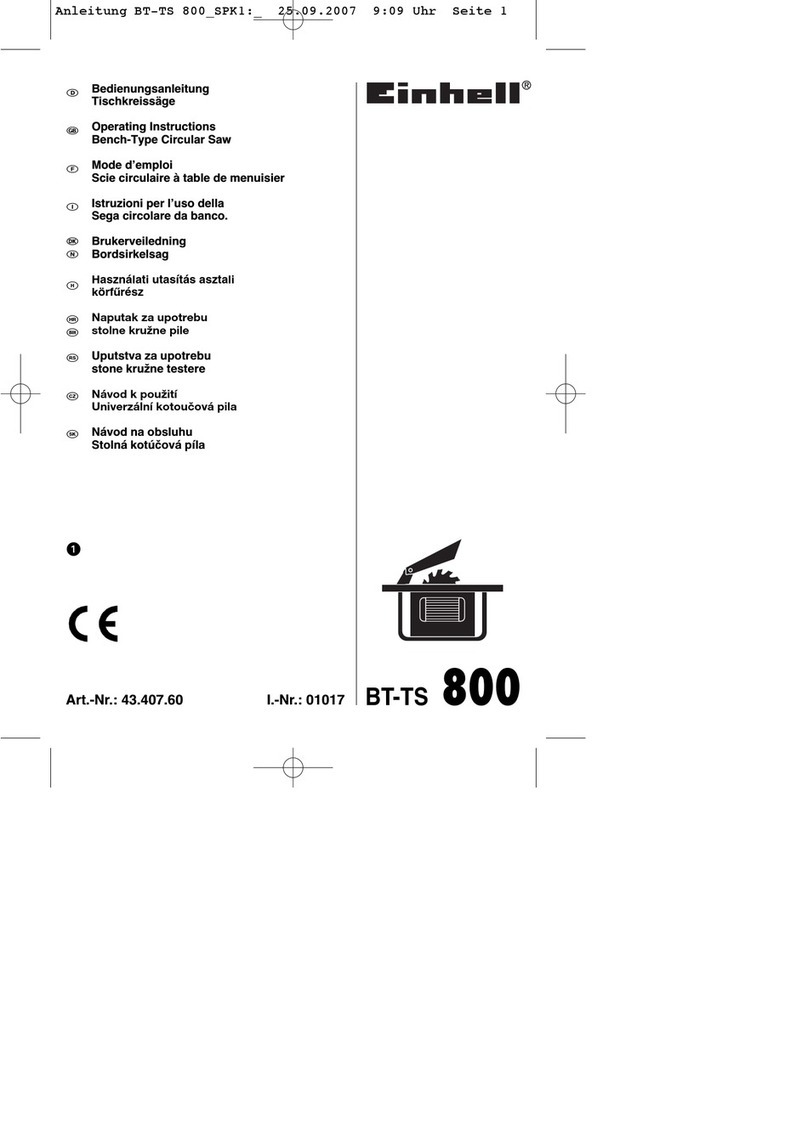Pearl PA7TT Owner's manual

serial number
7" PROFESSIONAL TABLETOP WET
TILE SAW - MODEL PA7TT™
OWNER’S/OPERATOR’S MANUAL
Caution! Read Safety and General Instructions carefully before using saw for the first time.
You should record the Serial Number of your Tile Saw on this Owner’s/Operator’s Manual
and on the Warranty Card. The Warranty Card must be sent back with all the required
pertinent information for the warranty to take effect.
Pearl Abrasive Co. 2.1 TILE SAW
REV. 1

PAGE
TABLE OF CONTENTS
I. GENERAL SAFETY RULES FOR ALL POWER TOOLS . . . . . . . . . . . . . . . . . . . . . . . . . . . . . . 3
II. SYMBOLS . . . . . . . . . . . . . . . . . . . . . . . . . . . . . . . . . . . . . . . . . . . . . . . . . . . . . . . . . . . . . . . . . . . . 4
III. FEATURES . . . . . . . . . . . . . . . . . . . . . . . . . . . . . . . . . . . . . . . . . . . . . . . . . . . . . . . . . . . . . . . . . . . 5
IV. SPECIFICATIONS . . . . . . . . . . . . . . . . . . . . . . . . . . . . . . . . . . . . . . . . . . . . . . . . . . . . . . . . . . . . . 5
V. UNPACKING. . . . . . . . . . . . . . . . . . . . . . . . . . . . . . . . . . . . . . . . . . . . . . . . . . . . . . . . . . . . . . . . . . 6
VI. INSTALLATION AND OPERATION. . . . . . . . . . . . . . . . . . . . . . . . . . . . . . . . . . . . . . . . . . . . . . . 6
VII. PROPER BLADE USE . . . . . . . . . . . . . . . . . . . . . . . . . . . . . . . . . . . . . . . . . . . . . . . . . . . . . . . . . . 8
VIII. SAFE OPERATING PRACTICES FOR TILE SAW . . . . . . . . . . . . . . . . . . . . . . . . . . . . . . . . . . . 9
IX. CARE AND MAINTENANCE . . . . . . . . . . . . . . . . . . . . . . . . . . . . . . . . . . . . . . . . . . . . . . . . . . . . 12
X. ELECTRICAL MOTOR SPECIFICATIONS . . . . . . . . . . . . . . . . . . . . . . . . . . . . . . . . . . . . . . . . . 14
XI. REPLACEMENT PARTS LIST . . . . . . . . . . . . . . . . . . . . . . . . . . . . . . . . . . . . . . . . . . . . . . . . . . . 15
XII. TROUBLESHOOTING . . . . . . . . . . . . . . . . . . . . . . . . . . . . . . . . . . . . . . . . . . . . . . . . . . . . . . . . . 18
XIII. ACCESSORIES AND PARTS . . . . . . . . . . . . . . . . . . . . . . . . . . . . . . . . . . . . . . . . . . . . . . . . . . . 18
XIV. THE RIGHT BLADES DOES THE RIGHT JOB . . . . . . . . . . . . . . . . . . . . . . . . . . . . . . . . . . . . . 19
XV. HOW TO ORDER PARTS . . . . . . . . . . . . . . . . . . . . . . . . . . . . . . . . . . . . . . . . . . . . . . . . . . . . . . 19

–3–
i. GENERAL SAFETY RULES FOR ALL POWER TOOLS
1. Know your power tool - read owner’s/operator’s manual carefully. Learn its applications and limitations as well as the specific
potential hazards unique to this tool.
2. Keep guards in place - and in working order.
3. Ground all tools - if tools are equipped with three prong plug, it should be plugged into a three-hole electrical receptacle. If an
adapter is used to accommodate a two-prong receptacle, the adapter lug must be attached to a known ground. Never remove
the third prong.
4. Remove wrenches - Form a habit of checking to see that adjusting wrenches are removed from tool before turning it “on”.
5. Keep work area clean. Cluttered areas and benches invite accidents.
6. Do not use in dangerous environment. Do not use power tools in damp or wet locations, or expose them to rain. Keep work area
well lighted. Do not use tool in the presence of flammable liquids or gasses.
7. Keep children and visitors away. All children and visitors should be kept at a safe distance from work area.
8. Make workshop childproof with padlocks, master switches or by removing starter keys.
9. Do not force tool. It will do the job better and be safer at the rate for which it was designed.
10. Use right tool. Do not force tool or attachment to do a job for which it was not designed.
11. Wear proper apparel. Do not wear loose clothing, gloves, neckties, rings, bracelets or other jewelry that may get caught in
moving parts. Non-slip footwear is recommended. Wear protective hair covering to contain long hair.
12. Always use safety glasses. Wear safety glasses (must comply with ANSI Z87.1) at all times. Everyday eyeglasses only
have impact resistant lenses; they are not safety glasses. Use face or dust mask if cutting operation is dusty, and ear protectors
(plugs or muffs) during extended periods of operation.
13. Do not overreach. Keep proper footing and balance at all times.
14.Maintain tools in top condition. Keep tools sharp and clean for best and safest performance. Follow instructions for lubricating
and changing accessories. Inspect tool cords periodically and if damaged, have repaired by authorized service facility.
15. Disconnect tools. When not in use, before servicing, and when changing accessories, such as blades, bits, cutters.
16. Avoid accidental starting. Make sure switch is in “off” position before plugging in power cord.
17. Use recommended accessories only. Consult the owner’s manual for recommended accessories. The use of improper
accessories may cause risk of injury to persons.
18. Never stand on tool. Serious injury could occur if the tool is tipped or if the cutting tool is accidentally contacted.
19.Check Damaged Parts. Before further use of the tool, a guard or other part that is damaged should be carefully checked to ensure
that it will operate properly and perform it’s intended function. Check for alignment of moving parts, binding of moving parts,
breakage of parts, mounting, and any other conditions that may affect it’s operation. A guard or part that is damaged should
be properly repaired or replaced.
20. Never leave tool running unattended. Turn power “off”. Do not leave tool until it comes to a complete stop.
Read all instructions. As with all machinery there are certain hazards involved with operation and use of
the machine. The following basic safety precautions should be followed at all times to reduce the risk of fire, electric shock and
serious personal injury to you or others. Keep these important operating instructions with this product.
WARNING!

– 4 –
KEEP GUARD IN PLACE
DIAMOND BLADE
BLADE CUTTING DEPTH
ELECTRIC SWITCH OFF
ELECTRIC SWITCH ON
ELECTRICAL HAZARD
REMOVE TOOLS
PAY EXTREME ATTENTION
REPAIRS TO BE DONE
MACHINE HAZARD
FLAMMABLE
READ INSTRUCTIONS
CAREFULLY
WARNING
FRAGILE
KEEP DRY
DO NOT STEP ON
WEAR HEARING PROTECTION
WEAR EYE PROTECTION
WEAR BREATHING PROTECTION
WEAR HARD HAT
WEAR PROTECTIVE CLOTHING
WEAR SAFETY SHOES
WELL VENTILATED
NO NON-WORKING PERSONNEL
21. Extension cords. Make sure your extension cord is in good condition. When using an extension cord, be sure to use one heavy
enough to carry the current your product will draw. An undersized cord will cause a drop in line voltage resulting in loss of power
and overheating. Extension cord tables (refer to page 21) show the correct size to use depending on cord length and nameplate
ampere rating. If in doubt, use the next heavier gage. The smaller the gage numbers the heavier the cord.
22. Do not abuse cord. Never carry tool by cord or pull it to disconnect from receptacle, Keep cord from heat, oil, and sharp edges.
23. Guard against electric shock. Prevent body contact with grounded surfaces. For example, pipes, radiators, ranges and
refrigerator enclosures.
24.Outdoor use extension cords. When tool is used outdoors, use only extension cords intended for use outdoors and so marked.
25. Stay alert. Watch what you are doing. Use common sense. Do not operate tool when you are tired.
26.Drugs, alcohol, medication. Do not operate tool while under the influence of drugs, alcohol or any medication.
27. Store idle tool. When not in use, tool should be stored in a dry and locked place, out of reach of children.
ii. SYMBOLS
CALIFORNIA PROPOSITION 65: Sawing and drilling generates dust. Excessive airborne particles
may cause irritation to eyes, skin and respiratory tract. To avoid breathing impairment always employ dust controls and
protection suitable to the material being saw or drilled in accordance with OSHA (29 CFR Part 1910.1). Diamond blades
improperly used are dangerous. Comply with ANSI Safety Code B7.1 and OSHA covering speed, safety guards, flanges,
mounting procedures, general operating rules, handling, storage and general machine condition.
WARNING!

– 5 –
iii. FEATURES
3/4 HP MOTOR
Generates more torque and is physically smaller and
lighter than similarly rated induction motors.
CUTTING TABLE
Rigid reinforced nylon
plastic table.
WATER PUMP
A high-output water pump
provides sufficient water
flow to cool the blade.
RE-USABLE AIR FILTER
Air intake to the motor is filtered by
a fire resistant filter, which can be
cleaned and re-used.
PA7TT TILE SAW
MOTOR MAX. BLADE
CAPACITY
CUTTING
LENGTH
CUTTING
DEPTH WEIGHT
DIMENSIONS
iv. SPECIFICATIONS
7" Blade
5/8" arbor blade
16" rip cut,
12" diagonal cut
1.5in
38mm 22 lbs. 20-3/16" L
x 18.7" W
x 12.7" H
3/4 HP
120 v, 60 Hz,
6,350 rpm
RIP GUIDE
Rip guide clamps from
the front and back.
RULER GUIDE
Built-in guide allows
convenient measurements
and promotes precision cuts.
WATER TRAY
Durable ABS
water tray.

– 6 –
vi. INSTALLATION AND OPERATION
1. Loosen blade guard adjustment knob located at
the rear of the blade guard. Raise the blade guard
to the highest position and retighten the knob.
2. Remove the blade shaft nut and outer flange. (see
figure 1) If a blade has been mounted, hold the
blade with one hand and use the other hand to
loosen the nut with the universal wrench. Remove
existing blade.
3. Mount new blade, but make certain the arrow on
the blade coincides with the rotation direction of
the shaft.
4. Attach outer flange and blade shaft nut. Hold the
blade with one hand and use the other hand to
tighten the nut with the universal wrench. Make
certain the flanges are pressed flush against the
blade and that the nut is firmly tightened, but do
not over tighten.
5. Loosen blade guard adjustment knob, lower the
blade guard and retighten the knob.
WARNING: Only use 7" blades on this
saw. Setting a smaller blade may cause
the blade to grab the material being cut,
possibly causing injury to the operator
and the saw.
Figure 1
v. UNPACKING
Open the container and carefully lift the saw by the foam packaging and place it on a flat, level working area.
Be sure that you have the following items before you discard the container:
• Saw
•ABS Water tray
•7” Saw blade
•Rip guide
•Universal wrench
•Water pump
•Owner’s manual
BLADE INSTALLATION

– 7 –
1. Remove the water pump from the box and
check that it is not damaged.
2. Place the pump within the water tray such that the
water outlet is horizontal. (see figure 2)
3. Connect the water hose from the blade guard to the
pump and plug the pump’s power cord into the
female plug that is attached to the post.
4. Fill the water tray so that the water intake is fully
immersed. Proper water level must be maintained
at all times during saw operation.
WARNING: Disconnect the pump before
attempting to handle the pump. Never
operate pump without water in the tray.
1. The ruler guide has markings along the top to allow
convenient measurements and to promote
precision cuts. (see figure 3)
2. The reinforced nylon cutting table spans an area of
16-1/8 x 17-3/8, which allows it to provide greater
support for handling larger materials.
3. A rip guide can be used.
1. Set the rip guide at the desired location on the ruler
and tighten the two threaded knobs.
2. After the rip guide is positioned for the desire cut,
place material flat against the rip guide.
3. Now you are ready to make your cut.
1. Lift the saw up from inside the water tray.
2. Flush water into the tray while holding it upright to
remove any sludge buildup.
3. Replace the saw back into the tray. (see figure 4)
1. Ensure that the water tray is empty and dry.
2. Unplug the power cord and store it in the water tray
Figure 2
Figure 3
WATER PUMP INSTALLATION
USING THE RIP GUIDE
USING THE CUTTING TABLE
RULER GUIDE
Figure 4
CLEANING THE WATER TRAY
TRANSPORTING THE SAW

– 8 –
DO’S
• Inspect blades daily for cracks or uneven wear.
• Always use appropriate blade for material
being cut.
• Inspect arbor shaft for uneven wear before
mounting blade.
• Always use blades with the correct arbor shaft size.
• Ensure that blade is mounted in the correct
direction.
• Use proper safety equipment when operating the
saw.
• Always have a continuous flow of water on both
sides of blade.
• Secure the blade to the arbor with a wrench.
DONT’S
• Do not operate the saw without safety guards in
position.
• Do not operate the saw with blades larger or
smaller than 7".
• Do not cut dry with blades marked “Use Wet”.
• Do not exceed manufacturer’s recommended
maximum RPM.
• Do not force blade into material. Let blade cut at
its own speed.
DO’S
• In addition to the following, always follow wet
recommendations.
• Use appropriate blade for material being cut.
• Inspect segment blades for segment cracking or
loss.
• Do not use damaged blades.
• Use proper safety equipment when operating the
saw.
DONT’S
• In addition to the following, always follow wet
recommendations.
• Do not make long cuts with dry blades. Allow them
to air cool.
• Do not use the edge or side of blade to cut or
grind.
• Do not attempt to cut a radius or curve.
• Do not cut too deep or too fast into the material.
• Do not cut any material not recommended by blade
manufacturer.
WET CUT BLADES
DRY CUT BLADES
vii. PROPER BLADE USE

– 9 –
viii. SAFE OPERATING PRACTICES FOR TILE SAW
1. Use safety equipment - wear safety approved hearing,
eye, head and respirator protection.
2. Read and understand the symbol definitions contained
in this manual.
3. Read and understand all warnings and instructions on
the machine.
4. Read all safety materials and instructions that
accompany any blade or accessory used with this
machine.
5. Establish a training program for all operations of this
machine.
6. Always provide a copy of this manual to the equipment
user. If you need extra copies call our Customer Service
Department at 1-800-969-5561.
7. Always select a diamond blade according to the
manufacturers recommendation suitable for the
material to be cut. Never use a blade having a
maximum operating speed lower than the “No load
R.P.M.” marked on the tool nameplate. Do not operate
any saw without safety guards in place or with a blade
diameter larger than the maximum saw blade capacity.
8. Before mounting a blade on the saw clean and inspect
the arbor shaft, blade flanges and the diamond blade
for uneven wear or damage. If it appears to be
damaged, Do not operate the tool. Have it serviced
by a qualified service technician.
9.Before each use of the saw, inspect the diamond blade
for hairline fatigue cracks. If such a crack or flaw is
evident, discard the blade. Using a damaged blade
may cause injury to the operator or others.
10. Be sure that the blade arbor hole matches the blade
adapter flange supplied with the saw. Use only blade
adapter flanges that came on your saw. Never use
damaged or worn blade adapter flanges.
11. Installing the blade, install the blade with the arrow
pointing the same direction as the rotation of the arbor
shaft or the arrow on the blade guard. Be sure to
tighten the blade shaft arbor nut with the wrench
provided. Be careful not to over tighten.
12. Check that the blade tracks near the center of the
channel in the main table, and that the table moves
freely from front to back.
13. Sometimes the material being cut is not abrasive
enough to expose new diamonds on the blade. If the
blade is not sharpened, it will rub against the surface
resulting in heat build up in the core. To prevent this, it
is necessary to dress the blade. To dress the blade
simply cut something that is very abrasive such as a
piece of cement block. Indications that the blade needs
dressing includes:
• The diamond in the matrix appear shiny because
they are worn flat.
• The blade stops cutting or noticeably slows down.
Blade dressing stones are available from your local Pearl
Warehouse.
14. Before using the saw fill the water tub enough to
submerge the water pump with clean water only.
Replenish as necessary and clean the water tub
frequently. Do not operate a wet cutting blade without
adequate water flow to both sides of the blade. Never
run the pump dry.
15. When cutting, always hold the material firmly lying flat,
supported by the main table with one edge resting
against the main table backstop.
•Do not attempt to cut pieces too small to safely
hold down on the main table.
The dust generated by cutting of
tile, marble, stone, bricks etc. can be injurious to your health.
Always operate machinery in well ventilated areas and
provide proper dust removal. Always wear a dust mask
approved for respiratory protection against these types of
dusts and mists.
For your own safety and the safety
of others do not attempt to operate this saw until you have
read and understand the general safety rules for all power
tools and the following additional safety precaution unique to
this saw.
WARNING!
WARNING!
Not dressing the blade frequently
or setting the blade too high will cause it to grab the tile
possibly causing injury to the operator and the saw. Setting
the blade depth too low will cause it to cut into the main table
that may result in injury.
WARNING!

– 10 –
•Never use the side of the blade to cut or grind
with, only cut in a straight line.
•Keep all parts of your body away from the blade
and all other moving parts.
•Never touch or try to stop a moving blade with
your hand.
16. When cutting dry - always unplug the water pump first.
Never run the pump dry.
•Do not use a wet cutting blade for dry cutting.
Select the proper dry cutting blade for your
application.
•Never make long continuous cuts with dry cutting
blades. To avoid heat build up, allow the blade to
cool, remove the tile and allow the blade to run
freely for a few minutes.
IMPORTANT - If there is any tendency for the saw to tip
or move during certain operations, such as when
cutting large heavy tile; the saw must be securely
fastened to a supporting table.
17. Make certain all adjusting knobs or locks are tight and
engaged in their detents and that movable parts not
intended to move during operation are securely locked
before making a cut. Be careful not to over tighten.
18. Before connecting the machine to a power source
check to see that the “On/Off” switch is in the “off”
position.
•Make sure the blade is not contacting anything
before connecting to a power source and starting
the motor.
•Know how to stop the machine quickly in case of
an emergency.
19. Grounding Instructions
•In the event of a malfunction or breakdown,
grounding provides a path of least resistance for
electric current to reduce the risk of electric
shock. This tool is equipped with an electric cord
having an equipment-grounding conductor and a
grounding plug. The plug must be plugged into a
matching outlet that is properly installed and
grounded in accordance with all local codes and
ordinances.
•Do not modify the plug provided - if it will not fit
the outlet, have the proper outlet installed by a
qualified electrician.
•Improper connection of the equipment-grounding
conductor can result in a risk of electric shock.
•Check with a qualified electrician or service
personnel if the grounding instructions are not
completely understood, or if in doubt as to
whether the tool is properly grounded.
•Use only 3 wire extension cords that have 3 prong
grounding plugs and 3 pole receptacles that
accept the tool’s plug.
Repair or replace damaged or worn cord immediately.
This tool is intended for use on a circuit that has an outlet that looks
like the one illustrated in Figure 5. The tool has a grounding plug
that looks like the plug illustrated in Figure 5(A). A temporary
adapter, which looks like the adapter illustrated in Figure 5(B) and
5(C), may be used to connect this plug to a 2 pole receptacle as
shown in Figure 5(B) if a properly grounded outlet is not available.
The temporary adapter should be used only until a properly
grounded outlet can be installed by a qualified electrician. The
green-colored rigid ear, lug, and the like, extending from the
adapter must be connected to a permanent ground such as a
properly grounded outlet box.
Note: USE OF A TEMPORARY ADAPTER IS NOT PERMITTED IN CANADA.
Additionally, water pump requires the use of a Ground Fault Circuit
Interrupter. Therefore, when using the water pump receptacle, this
tool must be plugged into a properly installed Ground Fault Circuit
Interrupter outlet. See Figure 5(D). If a Ground Fault Circuit
Interrupter outlet is not available, Pearl Abrasive Co. has it
available as an accessory item. A plug-in Ground Fault Circuit
Interrupter may be plugged into a properly installed and grounded
3-pole outlet. Refer to Figure 5(E).
20. Position of the Tile Saw
•To avoid the possibility of the appliance plug or
receptacle getting wet, position tile saw to one
side of a wall mounted receptacle to prevent
water from dripping onto the receptacle or plug.
The user should arrange a “drip loop” in the cord
connecting the saw to a receptacle. The “drip
loop” is that part of the cord below the level of
the receptacle, or the connector if an extension
cord is used, to prevent water traveling along the
cord and coming in contact with the receptacle.
See Figure 6.
NOTE - Use of a Temporary Adapter is not permitted in Canada.

– 11 –
•If the plug or receptacle does get wet,
Do not unplug the cord. Disconnect the fuse or
circuit breaker that supplies power to the tool.
Then unplug and examine for presence of water
in the receptacle.
21. Extension Cords
•Use only extension cords that are intended for
outdoor use. These extension cords are identified
by a marking “Acceptable for use with outdoor
appliances; store indoors while not in use.” Use
only extension cords having an electrical rating
not less than the rating of the product. Refer to
chart on page 14. Do not use damaged extension
cords. Examine extension cord before using and
replace if damaged. Do not abuse extension cords
and do not pull on any cord to disconnect. Keep
cord away from heat and sharp edges. Always
disconnect the extension cord from the
receptacle before disconnecting the saw
from the extension cord.
* Ground Fault Circuit Interrupter (GFCI) protection
should be provided on the circuit(s) or outlet(s) to
be used for the tile saw. Receptacles are
available having built-in GFCI protection and may
be used for this measure of safety.
(A) (B)
Figure 5
Grounding Methods
(C) (D) (E)
Grounding pin
Grounding pin
Cover of
grounded
outlet box
Metal
Screw
Grounding
Means
(Lug)
To reduce the risk of electrocution, keep all
connections dry and off the ground. Do not
touch plug with wet hands.
TOOL
Figure 6
Drip Loop
Supporting
Surface
Power Cord
Drip Loop

– 12 –
ix. CARE AND MAINTENANCE
For your safety before performing any maintenance on the saw turn off the power switch and unplug the power cord.
WARNING!
GENERAL RULES
•Always clean the machine before performing any
maintenance/ repair.
•Before performing any cleaning/maintenance
/repair, the machine must be switched off with the
main power switch.
Steps to Follow When Cleaning:
• Please do not use aggressive cleaners (i.e. containing
solvents). Do not use high-pressure water jets,
aggressive detergents or solutions and liquids with a
temperature exceeding 86ºF! Use a fluff-free cloth
only.
• Use a cloth which may be lightly moistened only for
removing dust and dirt. Hard packed dirt can be
removed with a soft brush.
• For the sake of safety, no water/cleaning liquid/vapor
may penetrate into the electric motor,
connectors/plugs, switches, etc. Therefore cover all
apertures, holes in the housing, connectors or plugs,
etc. or seal them with adhesive tape!
• Use a soft, low-pressure water jet and a brush to rinse
dirt and incrustations away. Be particularly careful
when near hazardous parts of the machine (e.g. switch,
motor). Clean the motor and switches only by wiping
with a moist cloth.
• Do not “rinse” the bearings of the drive elements to
prevent them from running dry. The ball bearings of the
machine are permanently lubricated.
• After cleaning, remove all covers and adhesive tape! All
screws/nuts which you may have loosened must be
tightened again!
• After wet cleaning, try the machine on a power outlet
which is equipped with a power breaker (i.e. fault
current circuit breaker). If the fault current circuit
breaker cuts the power supply, the machine must be
inspected by an authorized dealer prior to use!
CLEANING
After every use of the machine:
• Remove dirty water from container.
• Remove dirt and mud from the bottom of the container.
• Rinse the immersion pump with fresh water to prevent
the water pump from clogging with residual dirt.
After wet cleaning and before using the machine again:
• Connect the machine to an electric power outlet
equipped with a “GFCI” safety power breaker. If the
safety power breaker cuts off the electrical power
supply, do not try to operate the machine but have it
checked by an authorized dealer first.
PROLONGED PERIOD OF
NON-USE
Before not using the machine for a prolonged period of
time:
• Clean and lubricate all movable parts. However, do not
grease the guide rails.
After not using the machine for a prolonged period of
time:
• Check that the stand is safely fixed.
• Check that all screw joints and nuts are fixed.
• Check that the cutting table is seated properly on the
guide rails and that it moves easily along the entire
length of the rails.
• With the saw blade removed, switch on the motor for
an instant and switch it off again. If the motor does not
run, have the machine inspected by a qualified
electrician.
• Check that the immersion pump works properly. Turn
on the cooling water tap and switch the machine on. If
the pump does not give any water or only a little,
switch the machine off at once. Clean the pump, or
replace if necessary.

– 13 –
EXTREME TEMPERATURE
Ambient temperature below 32° F (Winter):
• To prevent the water in the pump and cooling system from
freezing, remove the water after using the machine or when
there will be a long break. Make sure that the cooling
system is entirely drained so that there is no water left
inside the pump and water hose!
WATER PUMP MAINTENANCE
When the machine has not been used for a long period of time,
hard packed dirt may begin to build up inside the pump and block
the pump wheel. If the machine is activated with the immersion
pump blocked, the electric motor of the pump will be damaged
within a few minutes! Please follow the steps listed below to
clean the pump before operating the saw:
1. Remove the immersion pump from the water container.
2. Clean the immersion pump.
3. Loosen the fixing screws of the pump lid.
4. Take the lid off the pump. Be careful not to damage
or lose the gasket underneath.
5. Clean the pump lid.
6. Remove all dirt and incrustations from the pump wheel.
7. Check whether the pump wheel can be easily turned.
8. Then reassemble the immersion pump correctly and
check whether it works properly.
REALIGNMENT
This procedure deals with the most common source of
misalignment that occurs when the guide rails are not
parallel with the blade.
1. Slightly loosen the screws (2) on the rip guide.
(see figure 7)
2. Loosen the knobs (2) on the rip guide. (see figure 7)
3. Carefully hold the rip guide flush against the blade.
4. Tighten the screws (2) on the rip guide.
Figure 7

– 14 –
x. ELETRICAL MOTOR SPECIFICATIONS
Horse Power 3/4 HP
Volts 120 V, 60hz
Amps 7.5 amps
Motor RPM 6,350 rpm
Cycle 60
Phase 1
PA7TT TILE SAW
WIRE
GAUGE
No. 12
No. 10
No. 8
LENGTH OF CORD
25'
50'
75'
Recommendations:
• It is recommended that a 7.5 amp circuit be used while operating this saw.
This will prevent possible power interruption or loss.
• Always plug saw as close as possible to the power source while operating.
This will allow you to receive optimum electricity.
Electrical Wiring Diagram
WARNING: To avoid permanent motor damage you must use the correct
extension cord. Never use more than one extension cord at a time. Follow the
chart for proper size.

– 15 –
xi. REPLACEMENT PARTS LIST
PA-7TT MAIN ASSEMBLY
PART NAME QTY PART NUMBER
1 Post 1 PA171214
2M8 x 1.25 x 50L Socket hex bolt 2 PA720009
3Cutting head assembly 1 PA171054
4Cutting head adjustment shim 8 PA171038
5M8 x 1.25 x 16L Flat point set screw 2 PA420274
6M8 x 1.25 Acorn nut 2 PA420015
7M8 Narrow washer 3 PA00016
8M8 Spring lock washer 3 PA00020
9M8 x 1.25 x 20L Socket head hex screw 3 PA00019
10 M8 x 1.25 Nut 1 PA00015
11 Rectangular anchor plate 2 PA00036
12 Wire protection cover 1 PA00031
13 M4 Spring lock washer 1 PA00039
14 M4 X 0.7 X 35L Cross screw 1 PA00076
15 Inner flange 1 PA00046
16 7" Circular blade 1 DIA07HPXL
17 5/8" Outer Flange 1 PA59900601
18 5/8" - 11 UNC Hex Nut 1 PA00063
19 Blade guard assembly 1 PA171076
20 3/8 wave 1 PA0310
21 5/16 - 18 x 3/4L Knob 1 PA00077
22 Table 1 PA171215
23 Water pump 1 PA171216
24 Water tray 1 PA171217
25 D8 flexible hose /feet 1 S1000-20.1
26 Rip guide 1 PA171218
27 6" 15 Amp GFCI with Female Twist Lock 1 V35018-REV

– 16 –
PA-7 MOTOR ASSEMBLY
PART NAME QTY PART NUMBER
1Motor replacement kit 1 PA171012
220A 125V/12A 250V Toggle switch 1 CX38085
3M4 x 1.59 x 8L cross tapping screw 4 PA230168
4Blade shaft gear 1 PA00023
5Cutting head housing 1 PA171008VX
6Blade shaft 1 PA171037
7Rear fan cover 1 PA00064
8Gear cover 1 PA00027
95 x 16 Woodruff key 1 PA420047
10 Wire anchor plate 1 PA00029
11 Wire seperation plate 1 PA00030
12 Particle filter 1 PA00032
13 D28 d20mm Oil seal 1 PA00033
14 Baffle 1 PA171072
15 14mm X 6mm Carbon brush(set of 2) 1 PA00035
16 L Anchor plate 1 PA171049
17 Power switch mounting plate 1 PA00050
18 Gasket 1 PA00060
19 M15 External C-clip 1 PA00044
20 2 Cable D9 cable grommet 1 PA0739
21 16AWGx3Cx0.3M 5-15R Power receptacle 1 PSV10033R
22 Power plug 1 S710-01
23
M4 x 1.59 x 10L Countersunk cross tapping screw
3 PA720008
24 D19 d6 Radial bearing 626 1 PA00047
25 M4 x 1.59 x 20L cross tapping screw 8 PA00059
26 D35 d15 Radial bearing 6202 ZZ 1 PA00056
27 M4 Spring Lock Washer 13 PA00039
28 M3 Spring Lock Washer 4 PA00041
29 M3 Narrow washer 4 PA00040
30 M4 Narrow washer 11 PA0146
31 M3 x 1.06 x 8L cross tapping screw 4 PA130037
PA-7TT MOTOR ASSEMBLY

– 17 –
PART NAME QTY PART NUMBER
1M3 Standard rivet 1 PA100053
2Retaining clip (Ø3.3mm mount hole) 1 PA100055
3D8 90 Degree elbow hose connector 2 PSV00008
4D8 Female quick disconnect T-adapter 1 PSV00005
5M6 x 1.0 x 16L Hex bolt 1 PA11089
6D8 flexible hose /feet 1 S1000-20.1
7M6 Narrow washer 1 PA00082
8M6 Spring Lock Washer 1 V3911090
9D6.4mm 90 degree elbow pipe 1 PA171164
10 Splash guard 1 PSV10023
PA-7TT BLADE GUARD ASSEMBLY

– 18 –
xii. TROUBLESHOOTING
For your safety and the safety of others, turn the power switch off and always remove the plug from power source before
troubleshooting. Repairs performed by unauthorized personnel could cause serious hazard. We recommend that service to this tool be performed by a
qualified service technician with original equipment replacement parts.
WARNING!
EXCESSIVE NOISE. Possible blade shaft bearing wear, motor belt
loose or motor fan rubbing on housing. Have tool serviced.
BLADE WILL NOT CUT. Check for worn out diamond edge. Be sure
that the arrow on the blade is rotating the same direction as the motor arbor
and/or arrow on the blade guard. Make sure the blade is suitable for the
material to be cut. If blade has been used to cut a material that is hard, it
may have become dull, dress the blade by cutting a light weight abrasive
building block to expose fresh diamonds. Blade dressing stones are available
from your local Pearl Warehouse.
MOTOR WILL NOT START. Check power supply. If the water
pump turns on when the power switch is in the “on” position, but the motor
does not, have the motor serviced.
MOTOR WILL NOT STOP. The contacts in the switch may have
become arched together in the on position, have it serviced.
MOTOR SHUTS OFF DURING OPERATION. Check to see
that the circuit you are using is not overloaded with lights or other equipment.
The fuse or circuit breaker may not have sufficient capacity, use 20-amp
power. If you are using an extension cord check the extension cord table to
be sure it is heavy enough to carry the current this product will draw. See
Page 14 for electric cord reference.
EXCESSIVE VIBRATION Check to see that the blade is mounted
properly according to safe operating practices section. Blade may be out of
balance, try a different blade. Arbor shaft bearings possibly worn, have tool
serviced.
NOT CUTTING SQUARE. Check the main table and carriage
adjustment as well as the blade alignment procedure located in the care and
maintenance section.
MAIN TABLE DOES NOT MOVE FREELY. Inspect the guide
rails and rollers for build up of tile chips or dry slurry deposits. Clean and
check guide roll or adjustments, according to the procedure in the care and
maintenance section.
NO WATER FLOW TO BLADE. Check the water feed tube for
kinks or obstructions. Check the inlet screen to ensure it is not clogged.
Remove the pump inlet and turn the impeller to ensure it is not damaged or
jammed. Clean the impeller if necessary and apply a drop of light oil to the
shaft - be sure the impeller spins freely.
POOR MACHINE PERFORMANCE WITH LITTLE
POWER. Check cord/extension cable for appropriate length and gage.
Check power network for sufficient power and circuit breaker capacity.
CENTER HOLE IN BLADE OVERSIZE OR WORN. Saw
blade has slipped on shaft while running. Check shaft for damage and replace
blade.

– 19 –
xv. HOW TO ORDER PARTS
Please have the following information ready before calling:
• Serial Number of your Tile Saw
• Model Number of the Tile Saw
• When purchased and where
• Part Description
All parts listed may be ordered from your Local warehouses. If the part is not stocked locally, call our Corporate office and ask for our Customer
Service Department. For Technical Support call 1-800-969-5561. In Canada call 1-800-387-0008. There is a $25.00 minimum order.
Return Policy: Return goods for credit or exchange on the basis of the following terms: (1) They must be current products; (2) Items returned for
replacement or refund should be in original cartons and must be accompanied by a packing slip with the following information: Returned Goods
Authorization (RGA) number obtainable from Customer Service Department • List of items returned • Reason(s) for return(s) • Copy of original
invoice(s); (3) Freight charges must be assumed by sender; (4) Returning goods are subject to a 15% handling charge to cover our cost of
repacking and restocking. All Prices are subject to change without notice.
Disclaimer: Pearl Abrasive Co. reserves the right to make changes or improvements on its products without incurring an additional obligation
including any obligation to make corresponding changes or improvements to products previously manufactured or sold. Pearl reserves the right
to discontinue products at any time without notice.
All illustrations displayed in this manual are the property of Pearl Abrasive Co. and shall not be duplicated or reproduced without the express
written consent of Pearl Abrasive Co.
xiv. THE RIGHT BLADE DOES THE RIGHT JOB
For the most effective cutting and blade life always use the recommended Pearl Abrasive Co. blade.
APPLICATION
PEARL
BLADE
SERIES
Reactor ADM
HPXL Series
HP Series
Thin Turbo Mesh
DTLB19 Series
Pro-V Series
Glass Blade
SH Series
CERAMIC EXTRA HARD PORCELAIN MARBLE GRANITE HARDSTONE GLASS TILE MOSAIC
TILE CERAMIC METAL TILES

Part No. PA7TTMAN • 01/23
GEORGIA • USA
455 SATELLITE BOULEVARD
SUWANEE, GA 30024
ONTARIO • CANADA
375-2 PIDO ROAD
PETERBOROUGH, ONTARIO K9J-6X7
CORPORATE OFFICE: SO. CALIFORNIA • USA
4900 ZAMBRANO ST., COMMERCE, CA 90040-0031
562-927-5561 • FAX 562-928-3857
Toll Free: 800-969-5561
www.pearlabrasive.com
Table of contents
Other Pearl Saw manuals
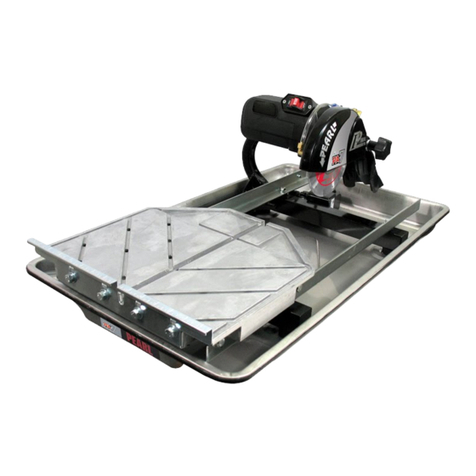
Pearl
Pearl PA-7 Owner's manual
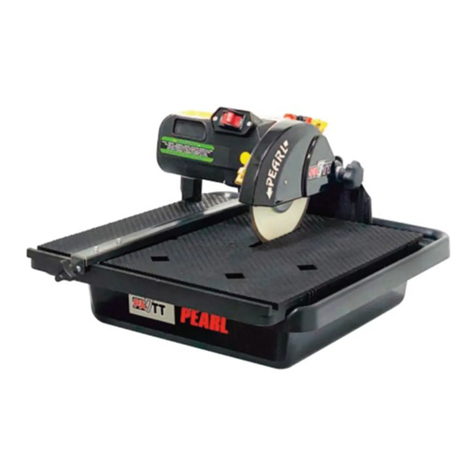
Pearl
Pearl PA7TTR Owner's manual
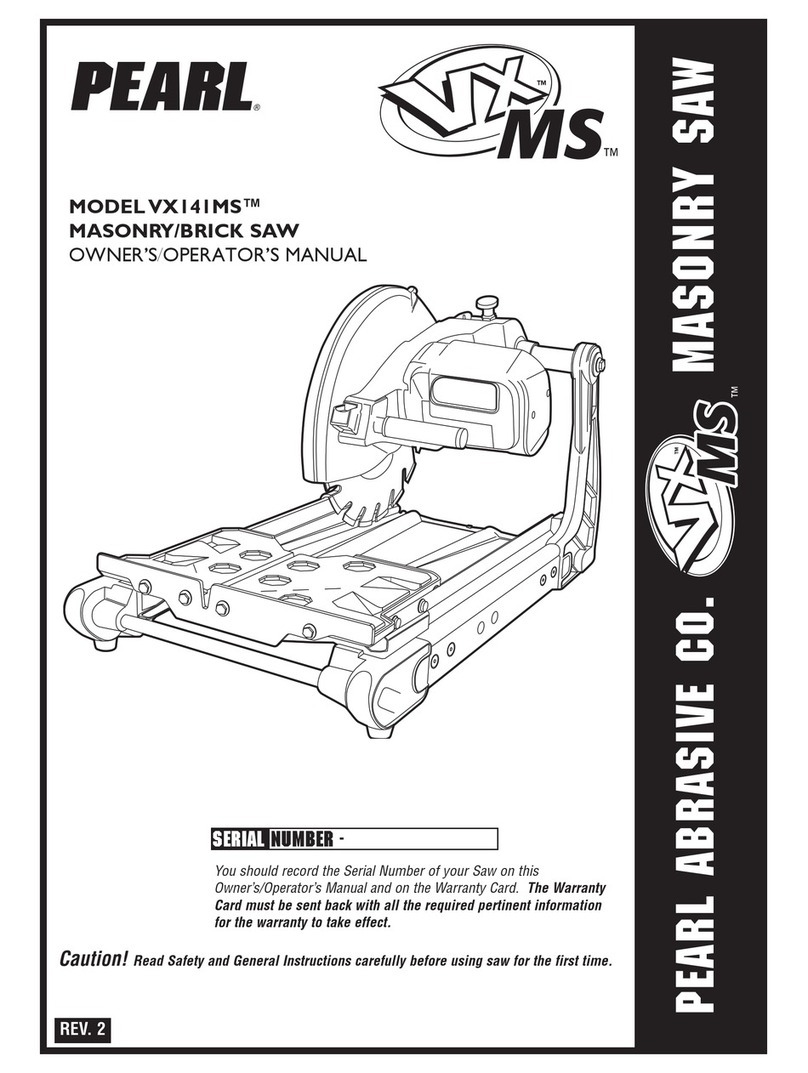
Pearl
Pearl VX141MS User manual

Pearl
Pearl VX5WV Owner's manual
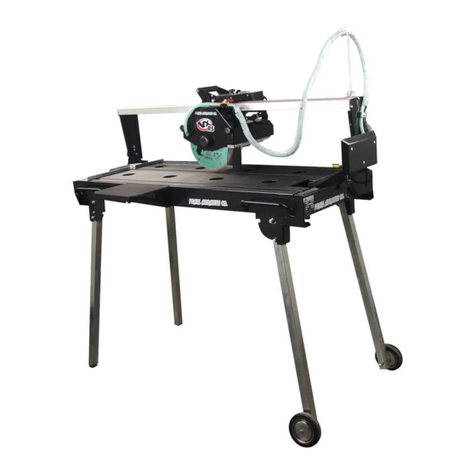
Pearl
Pearl VX RSPRO R Owner's manual

Pearl
Pearl VX141MSD Owner's manual
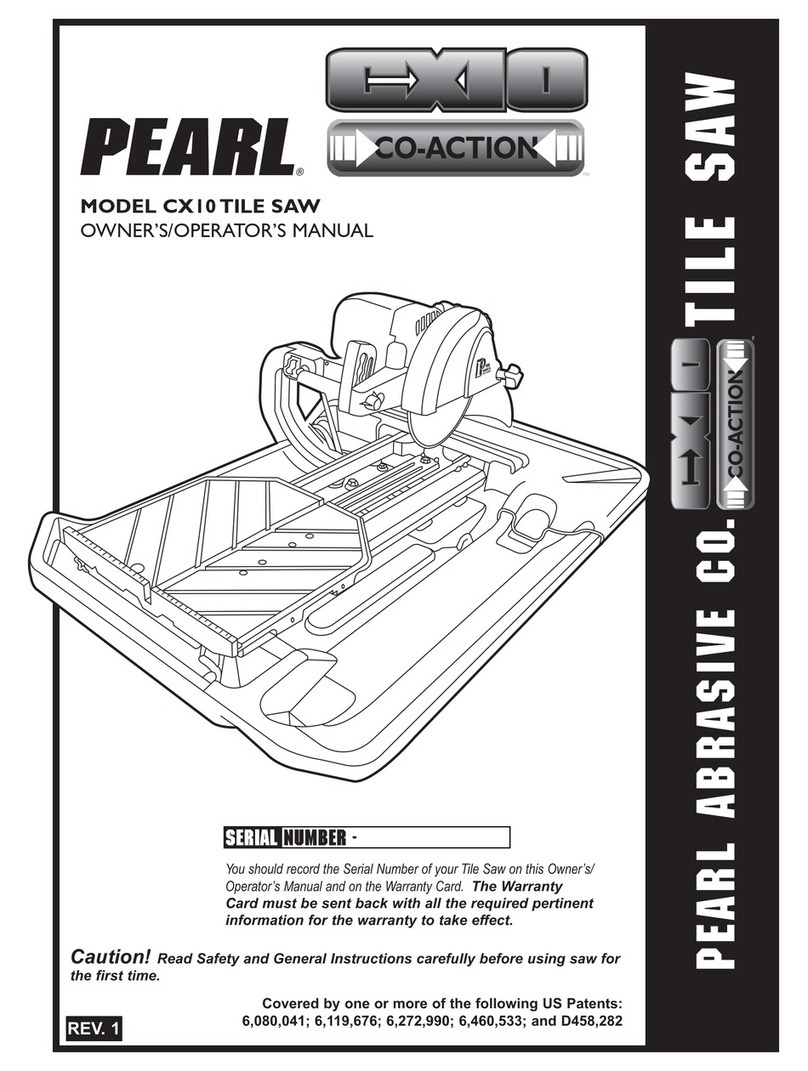
Pearl
Pearl CX10 Owner's manual
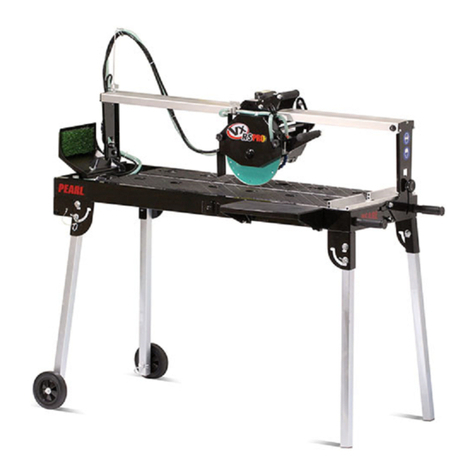
Pearl
Pearl VX10RSPRO Owner's manual

Pearl
Pearl VX141MS User manual
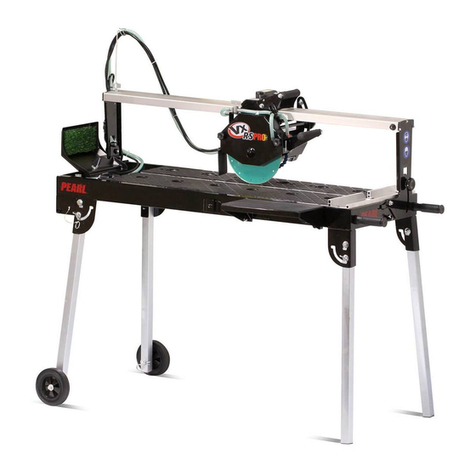
Pearl
Pearl VX RSPRO VX1048RSPRO Owner's manual
